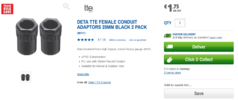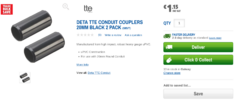- Joined
- 26 Feb 2024
- Messages
- 5
- Reaction score
- 0
- Country

Hi,
We have an EV charger installed. Both power and 2x Ethernet cables were run from the consumer unit, through the attic, out a hole and down a outdoors wall to the isolator and charger. The outdoor section of the run is shown below:

The OBO box is ip65 rated and covers the exit hole from the attic. The power and Ethernets are separated and sent down two 20mm conduits. One conduit with the power terminates at the isolator, the other continues to the charger (Note, the conduits are yet to be clipped).

6mm sq twin and earth is used to carry the power, and goes from the consumer unit to the isolator outdoors with the only break being at the isolator.

The conduit and connectors used were these from Screwfix:



My question is this: Is this cable management (connectors, conduit, etc) suitable for this set-up? My worry is that this connectors are not weatherproof enough, but im not sure what the alternative is for twin and earth. An electrician friend is going to give it a look over before the final connection, but I would like to have my ducks in a row before I get laughed out of it and put work on him fixing it.
Thanks!
We have an EV charger installed. Both power and 2x Ethernet cables were run from the consumer unit, through the attic, out a hole and down a outdoors wall to the isolator and charger. The outdoor section of the run is shown below:
The OBO box is ip65 rated and covers the exit hole from the attic. The power and Ethernets are separated and sent down two 20mm conduits. One conduit with the power terminates at the isolator, the other continues to the charger (Note, the conduits are yet to be clipped).
6mm sq twin and earth is used to carry the power, and goes from the consumer unit to the isolator outdoors with the only break being at the isolator.
The conduit and connectors used were these from Screwfix:
My question is this: Is this cable management (connectors, conduit, etc) suitable for this set-up? My worry is that this connectors are not weatherproof enough, but im not sure what the alternative is for twin and earth. An electrician friend is going to give it a look over before the final connection, but I would like to have my ducks in a row before I get laughed out of it and put work on him fixing it.
Thanks!
Attachments
Last edited:


